Candlelight vigil
A candlelight vigil or candlelit vigil is an outdoor assembly of people carrying candles, held after sunset in order to show support for a specific cause.[1] Such events are typically held either to protest the suffering of some marginalized group of people, or in memory of the dead. In the latter case, the event is often called a candlelight memorial. A large candlelight vigil will usually have invited speakers with a public address system and may be covered by local or national media. Speakers give their speech at the beginning of the vigil to explain why they are holding a vigil and what it represents.[2] Vigils may also have a religious or spiritual purpose. On Christmas Eve many churches hold a candlelight vigil.
Candlelight vigils are seen as a nonviolent way to raise awareness of a cause and to motivate change, as well as uniting and supporting those attending the vigil.[1]
South Korea's candlelight vigils
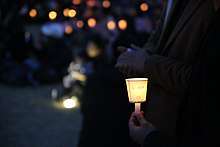
In South Korea, the Candlelight vigils.,[3] also referred to as the Candlelight Struggle,[4] Candlelight Revolution,[5] or Candlelight protests[6] is a symbolic collective gathering of political dissent in South Korea to combat injustice peacefully.[7] This method of protesting began in 2002 as a result of the Yangju highway incident,[3] was utilized in the rallies against the impeachment of Roh Moo-hyun in 2004, re-used again in the 2008 U.S. beef protests, and emerged in the 2016-18 President Park Geun-hye protests.[8]
2002
Background
On June 13, 2002, two fourteen-year-old Korean middle-school girls, Shim Mi-sun (Korean: 심미선) and Shin Hyo-seon (Korean: 신효순), were struck and killed by a U.S. military vehicle in Yangju, Gyeonggi province on Highway 56, just 300 meters away from a friend's birthday party.[9] The Korean government did not have any jurisdiction over the trial due to the U.S. military having their legal rights presided over by the Status of Forces Agreement, which doesn't hold them accountable to the Korean court.[10] This resulted in public outrage once the U.S. court-martials determined that the G.I. soldier, Sergeant Mark Walker, and the vehicle's commander, Sergeant Fernando Nino, were not guilty of "negligent homicide" of the 60-ton U.S. tracked bridge carrier that killed the girls during their training exercise.[11]
Demonstrations
On November 20, 2002, the U.S. military court made its first verdict of not guilty for the soldiers involved in the incident, triggering the re-emergence of the girls' crushed bodies being spread online after initially taking them down to respect their deaths.[10] News of this incident and the trial's outcome was circulated through a TV documentary, which amassed an online community that viewed this incident as a "National Tragedy", resulting in nationwide candlelight vigils being held at the suggestion of a netizen in an internet cafe to collectively mourn the death of the girls.[10][3] On November 30, about 30,000 Koreans gathered in Gwanghwamun for the first mass candlelight vigil to commemorate the girls and protest their injustice death as people sang the national anthem and voiced their demands.[12] The mishandling of this case by the U.S. and the Korean government mobilized the vigils to gain momentum as they began to be held every weekend from November 2002 up until late January 2003.[10] Following the protests, on November 27 President Bush issued a statement of apology through an American ambassador, but it was met with discontent from netizens as they sought for a direct apology from Bush and for the soldiers involved in the incident to be held accountable for their crimes.[13]
Following these events, the protesters had three demands they attempted to achieve, which outlined the following: (1) that the jurisdiction of the case be handed over to the South Korean court, (2) That an amendment should be made onto The Status of Forces Agreement to eliminate the autonomy U.S. servicemen have in evading the South Korean government and punishment, and (3) that President Bush, issue a statement of apology for death of the middle school girls.[14] The vigils that continued to take place were labeled by some Korean media sources as "anti-Americanist"[15] while others viewed it as a platform for self-expression for the younger generation.[10] On December 7, the netizens who were participating in one of the 43 city-wide candlelight protests in Gwanghwamun broke through the police blockade and made their way to the U.S. embassy where they persistently tried to persuade them to apologize and seek appropriate justice.[12] The last mass vigil took place on December 14, with about 100,000 people from over 60 cities and 15 countries gathering at Gwanghwamun Square in Seoul. Revisions were made to The Status of Forces Agreement as a result of these demonstrations.[16] Since the incident, candlelight vigils have become a staple protest culture in South Korea.[7]
2004
Background

On a national televised news conference in 2004, President Roh displayed no remorse over his brother's bribe scandal and instead, blamed the construction company executive involved for exploiting a "lesser educated man".[17] The following day, Roh also expressed his support for the Uri party and refused to publicly apologize, defiantly going against the parliament's demand for one, which caused the last traces of parliament support for Roh to cease.[17] On March 12, members of the conservative oppositional party impeached Roh on the grounds of him violating "political neutrality" when he asked the nation to support the newly established Uri party for the April 15 elections.[18][17][19] The National Assembly stripped Roh from his role as the head of state and chief commander soon after the voting session had ended, with Prime Minister Goh Kun stepping up as the interim President of South Korea.[20] Despite Prime Minister Goh's assurance to the public that he would maintain Roh's policies with North Korea and the United States as well as protect South Korea's economy from going into chaos, Roh's supporters met the news of impeachment with hostility, rage, and as an embarrassment to their country due to Roh being the first democratically elected leader to be impeached.[21][17]
Demonstrations
Roh's presidential win in 2003 was attributed to his self-made image and need for justice, especially following the events of the army vehicle that killed the two girls and the acquittals given to the perpetrators, which to many Koreans highlighted the unequal footing their country had with America.[18] On March 7, 2004, 170 of Roh's supporters rallied against the impeachment motion by holding a candlelight vigil on the streets of Seoul 5 days before the National Assembly would vote on it.[20] There were also various protests held in Seoul, Busan, Daegu, and Kwangju in response to the impeachment proceedings as the movement gained momentum through the internet.[22][23] About 12,000 of Roh's supporters held a candlelight protest outside of the capital's National Assembly shouting "Impeachment is null and void” on the day the impeachment was announced.[22] The amount of supporters who protested against the impeachment motion reached 70,000 the following day.[22] Weekly rallies were held in March across the country, with March 20th having the highest turnout numbers of about 200,000 supporters, according to the rally organizers.[20] The backlash that the conservative party received for impeaching Roh was felt through the high voter turnout for the April 15th election, that resulted in the Uri party winning 152 seats, gaining the majority in the National Assembly.[20] The demonstrations and support from the people led to Roh's impeachment to be retracted on May 14, on orders of the constitutional court.[24][20]
2008
Main articles: United States beef imports in South Korea and 2008 US beef protest in South Korea
Background
On April 18, 2008, the ban that the Korean government had implemented on the importation of U.S. beef due to a case of mad-cow disease in 2003 was lifted in an agreement directed by South Korea's President Lee Myung-bak and U.S. President Bush.[3] This move caused a public outroar in response to a TV Program broadcast on MBC regarding food safety and the unknown risks of American beef.[25] The broadcast also honed in on the unequal terms of the agreement that did not have any precautions set in the event that a BSE outbreak would be detected in the United States.[26] In addition, the media portrayed this agreement as the South Korean government succumbing to the trade pressure of the United States.[26]
Demonstrations
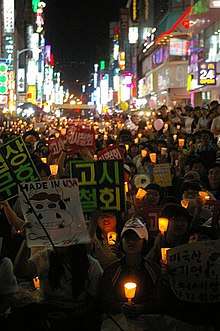
On May 2, 2008, the streets of Seoul were filled with hundreds of secondary and college students that orchestrated a candlelight vigil via text messages and the internet in protest of the agreement.[27] Thereafter, the candlelight protests became a daily occurrence, with 100,000 people gathering to rally against the agreement and calling for the impeachment of President Lee, which had garnered 1.2 million signatures online on May 6.[28][27] On May 22, the Korean government announced that they would attempt to exclude certain parts of U.S. beef that may be more receptive to mad cow disease as the President offered an apology for disregarding the public's health concerns, but this did not quell their grievances.[26][28] Protests erupted in Busan, Chuncheon, Daegu, and Gwangju, with the end of May ushering 211 arrests on protestors for displaying political slogans and signs that the Korean government had warned against utilizing.[27] During the third week of June, President Lee's cabinet stepped down from their position due to the enormous amount of pressure they received from the protestors.[27] On June 25, another agreement was discussed wherein President Lee lifted the ban on U.S. beef from cattle that were less than 30 months old.[27] In response, a protest was organized by the People's Association Against Mad Cow Disease, leading to 91 arrests.[27] Other protesters attempted to make their way to the president's office but were detained by police.[27] On June 30, a wave of a new march was headed by the Korean Confederation of Trade Unions (KCTU) with hundreds of its members coming out to protest.[27] The candlelight protests lasted from May 2008 until August 2008 and is remembered as a mass movement that emerged from the South Korean government's failure to hold the trust of the people.[25]
2016-17
Background
Main articles: 2016 South Korean political scandal and Park Geun-Hye
.jpg)
In October 2016, President Park Geun-hye was revealed to be involved in a corruption scandal that focused on the nature of her friendship with Choi Soon-il, the daughter of cult leader Choi Tae-min.[29] JTBC were the first to report on the case, revealing that Choi had access and exerted influence over Park's state affairs, including classified information that should not have been leaked to an individual with no government rank or status.[30][29] On October 25, Park released a statement of apology for giving Choi access to her drafted speeches during the early months of her presidency.[31] A week later, Choi was arrested for the suspicion of employing improper influence on state affairs.[31] Later on, the investigation revealed that Park and Choi accepted and demanded bribes from South Korean conglomerates, which were then funneled to Choi's family and to her non-profit organizations.[32]
Demonstrations
Main articles: Impeachment of Park Geun-hye and 2016–17 South Korean protests
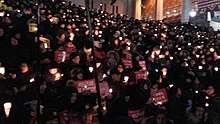
The candlelight protests initially started in October 2016 and lasted until March 2017.[33] The first candlelight vigil was held on October 29, shortly after the corruption scandal was disseminated through the media.[33] The protests that were held came to be known as the Candlelight Revolution and amassed over 2 million protestors in Gwanghwamun Square in early December.[33][34] The Candlelight Revolution pressured the National Assembly into processing the impeachment of Park, with the Constitutional Court approving the motion on March 11, 2017 as the rallies continued throughout the months with fervor.[33] On February 13, 2018, Choi was sentenced to 20 years in prison for corruption and on April 6 of the same year, Park was found guilty of corruption, coercion, abuse of power, and leaking classified information, which amounted to her final sentence being a total of 24 years in prison.[32]
Gallery
 2010 National Police Week 22nd annual candlelight vigil at the National Law Enforcement Officers Memorial at Judiciary Square, Washington, D.C.
2010 National Police Week 22nd annual candlelight vigil at the National Law Enforcement Officers Memorial at Judiciary Square, Washington, D.C.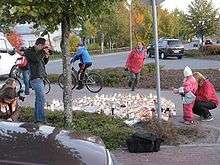
- Every year since 1990, people attend candlelight vigils on June 4 in Victoria Park, Hong Kong commemorating the victims of 1989 Tiananmen Square protests.
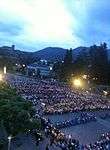 A candlelight vigil in Lourdes, France.
A candlelight vigil in Lourdes, France.
See also
References
- "love to know: Organise a candlelight vigil". Retrieved 28 December 2012.
- "Do Something: how to organise a vigil". Retrieved 28 December 2012.
- Shinn, Henry (4 April 2010). "Deja vu? Candlelight vigils in 2002 and present". The Korea Herald. Retrieved 14 March 2019.
- Han, Ju-yeon (7 December 2017). "Candlelight demonstration participants receive human rights award in Berlin". Hankyoreh. Retrieved 14 March 2019.
- Cho, Elliot (13 December 2016). "South Korea's 'Candlelight Revolution' Matters". Huffington Post. Retrieved 14 March 2019.
- Kim, Yong-cheol; Kim, June-woo (2009). "South Korean Democracy in the Digital Age: The Candlelight Protests and the Internet". 40 (1): 53–85. ProQuest 209355027. Cite journal requires
|journal=(help) - Premack, Rachel (2 December 2016). "Koreans Have Mastered the Art of the Protest". Foreign Policy. Retrieved 9 March 2019.
- "South Korea: thousands of protesters call for president to resign". The Guardian. 29 October 2016. Retrieved 14 March 2019.
- Jin, Myeong-seon (12 June 2012). "Tenth anniversary of girls killed by US military armored vehicle". Hankyoreh. Retrieved 9 March 2019.
- Kang, Jiyeon (June 2009). "Coming to Terms with "Unreasonable" Global Power: The 2002 South Korean Candlelight Vigils". Communication and Critical/Cultural Studies. 6 (2): 171–192. doi:10.1080/14791420902833155.
- "US soldiers charged for Korean deaths". July 5, 2002. Retrieved 21 February 2019.
- Han, Soul. "South Koreans protest against the mishandling of the deaths of two Korean students caused by U.S. Army, 2002-2004". Global Nonviolent Action Database. Retrieved 7 March 2019.
- Kirk, Don (28 November 2002). "Bush Apologizes to Koreans For Killing of 2 Girls by G.I.'s". The New York Times. Retrieved 9 March 2019.
- "Protest U.S. Army Killing of Shin Hyo Soon and Shim Mi Sun, two 13-year-old girls in south Korea". The International Action Center. Korea Truth Commission and The International Action Center. Archived from the original on 16 July 2017. Retrieved 9 March 2019.
- Salmon, Andrew. "Nationalistic furies ignited anti-Americanism in 2002". The Korea Times. Retrieved 9 March 2019.
- Yun, Seongyi; Woo, Young Chan (2011). "New Media and Political Socialization of Teenagers: The Case of the 2008 Candlelight Protests in Korea". Asian Perspective. 35 (1): 135–162. doi:10.1353/apr.2011.0019. Retrieved 16 March 2019.
- Lev, Michael (14 March 2004). "S. Koreans sorting out impeachment". Chicago Tribune. Retrieved 15 March 2019.
- Pastreich, Emanuel (3 August 2005). "The Balancer: Roh Moo-hyun's Vision of Korean Politics and the Future of Northeast Asia". The Asia-Pacific Journal Japan Focus. 3 (8). Retrieved 15 March 2019.
- "Obituary: Roh Moo-hyun". BBC News. 23 May 2009. Retrieved 15 March 2019.
- Kim, Da-sol (8 December 2016). "Revisiting Roh Moo-hyun impeachment". The Korean Herald. Retrieved 15 March 2019.
- Len, Samuel (13 March 2004). "President's Impeachment Stirs Angry Protests in South Korea". The New York TImes. Retrieved 15 March 2019.
- "President's impeachment infuriates South Koreans". The Washington Times. 12 March 2004. Retrieved 15 March 2019.
- Kim, Youngmi (2009). "Digital Populism in South Korea? Internet Culture and the Trouble with Direct Participation". On Korea: Academic Papers Series. 3 (8): 114–126. Retrieved 15 March 2019.
- Murray, Lorraine. "Roh Moo-Hyun PRESIDENT OF SOUTH KOREA". Britannica. Encyclopaedia Britannica. Retrieved 15 March 2019.
- Han, Do-hyun (September 2010). "Contemporary Korean Society Viewed through the Lens of the Candlelight Vigils of 2008". Korea Journal. 50 (3): 5–13. Retrieved 15 March 2019.
- Jin, Hyun (2014). "The 2008 US beef scare episode in South Korea: Analysis of an unusual public reaction". Journal of Public Health Policy. 35 (4): 518–537. doi:10.1057/jphp.2014.33. PMID 25164598. Retrieved 15 March 2019.
- Alicea, Julio. "South Koreans protest government's lift of ban on US beef, 2008". Global Nonviolent Action Database. Swarthmore College. Retrieved 15 March 2019.
- Kim, Jack (31 May 2008). "Anti-U.S. beef protest draws 100,000 S.Koreans". Reuters. Retrieved 15 March 2019.
- "South Korea's presidential scandal". BBC News. 6 April 2018. Retrieved 16 March 2019.
- Williams, Jennifer (6 April 2018). "South Korea's former president is going to prison. The scandal behind it is batshit". Vox. Retrieved 16 March 2019.
- Park, Ju-min (29 March 2017). "Timeline: South Korea's impeached President Park Geun-hye". Reuters. Retrieved 16 March 2019.
- "Ousted South Korea President Park Geun Hye jailed for 24 years over corruption". The Straits Times. 6 April 2018. Retrieved 16 March 2019.
- Lee, Taeho (2018). "Korea's Candlelight Revolution and Participatory Democracy". International House of Japan and Japan Foundation. Retrieved 16 March 2019.
- "In Korea, candlelight vigil spreads "Light of Peace"". World Council of Churches. 6 December 2017. Retrieved 16 March 2019.
External links
| Wikimedia Commons has media related to Candlelight vigils. |